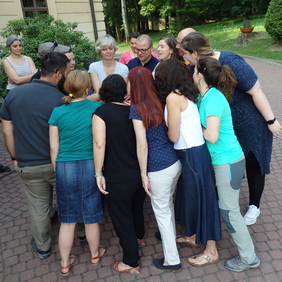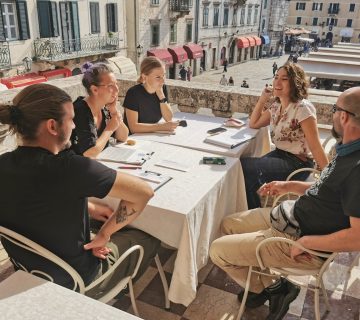My experience has led me to believe that interpretation of cultural heritage is not just a tool, it is more of a lifestyle. The Interpret Europe Summer Courses for Certified Interpretive Guides/Trainers (CIG/CIT) this summer in Poland offered proof of just that. It did even more; it brought together one of the most connected groups I have ever had the chance to meet in one place. This made the biggest impact on me during the week. We started as colleagues and like-minded professionals and ended up as friends, co-workers and activists engaged around the common love for culture and cultural heritage.
Individually and together, we learned about the theory of heritage interpretation and the vast universe of concepts, such as facts and meanings, phenomena and themes, interpretive talks and walks, mind mapping and accessibility, roving and live interpretation. The theory was not given to us or implanted into our heads – each slice of knowledge was earned through practical exercises and examples. 90% of the time was spent outdoors and hands-on. There was no escape or possibility for the ‘I will do it later’ mentality. It pushed our boundaries and made us more vulnerable – in a good way. It did exactly what good practice heritage interpretation does on site.
Having had the privilege and honour to work with 50 European States in celebrating and defining their meaning of European heritage during the last ten years, I have realised three things: 1) celebration of cultural diversity and similarities brings together the best possible people; 2) storytelling and relationship building is the future of protecting our common heritage; and 3) local communities generally do not know how valuable their local heritage is.
Heritage interpretation goes along the same lines. It truly brings together the best possible people. Relationship building and storytelling are the main pillars of the concept – you need to not just engage the community, but rather work with them to showcase their best abilities and empower them to take responsibility for telling their own story/stories. And finally, the role of heritage interpreter is to guide the community in realising the value of their unique perspective(s).
Once you get a grasp of what interpretation is, you will never look at the world in the same way again. A tree is never just a tree, a fact is never just a fact, a person is never just a person – it is a treasure chest full of unrevealed potential to tell a story and many stories to people around you. It is a way to create multiple narratives and open minds and, ultimately, make connections to people and phenomena that you might not otherwise encounter.
In the era where everyone claims we are more disconnected than ever, heritage interpretation gives room to empathy and compassion and universal human values and that is something that everyone should get certified in. I sure am glad I had the opportunity to do so.
Jelena Močević is a storyteller and relationship builder in charge of the European Heritage Days Programme at the Council of Europe. She is a heritage enthusiast and believer in the human approach to development of local communities. You may reach her at: jelena.mocevic@interpret-europe.net
To cite this article:
Močević, Jelena (2018) ‘Why heritage interpretation is much more than just a tool’. In Interpret Europe Newsletter 3-2018, 9.
Available online:
www.interpret-europe.net/fileadmin/Documents/publications/Newsletters/ie-newsletter_2018-3_autumn.pdf




